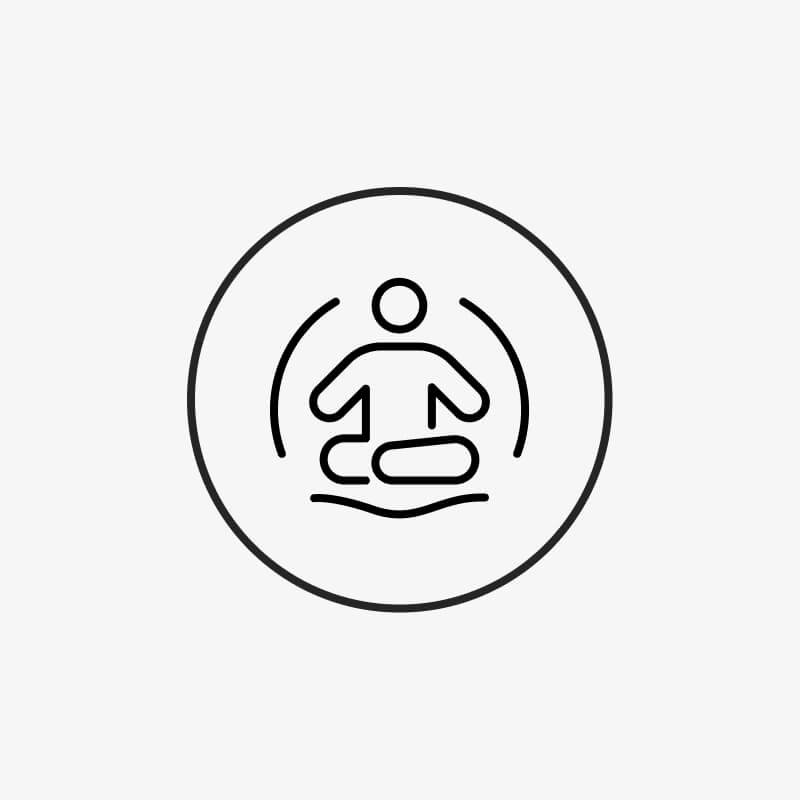Your calendar is full, the phone is constantly ringing, one email after another lands in your inbox, your employees need your advice, and at the same time, the pressure to deliver results is increasing. Sound familiar? Then these tips for more mindfulness are just right for you to optimize your leadership skills.
What is mindfulness anyway?
The practice of mindfulness originally comes from Buddhism. Many people are familiar with the term from yoga or meditation: being mindful means being in the here and now, both physically and mentally. This mental awareness of the moment is often lost these days, as the mind is distracted from all sides. This makes it all the more important to allow your thoughts to calm down every now and then and to focus on the present moment. Mindfulness is also about contentment. If you don't worry about the past or the future, you can concentrate better on what's important - the moment, right now. Another aspect of mindfulness is not judging the moment you are experiencing, neither negatively nor positively. Simply perceiving it and accepting it as it is.
Take-Home Message #1: Mindfulness means being consciously present in the here and now without judging the moment.
Why is mindfulness so important for leaders?
If you manage to calm and focus your thoughts, you will demonstrably gain the mental strength that helps you keep a cool head in stressful situations [1]. You can focus on what's important, make the right decisions, and lead your team to success. You can block out negative thoughts and emotions and give your full attention to the situation in the present. Because now is the time to act, not yesterday and not tomorrow! As a leader, you are the rock in the surf that your employees need. Or the mountain guide who takes them to the summit. Only a good leader reaches their goal - and thus to success. Negative emotions such as fear of failure or outbursts of anger because the hoped-for results don't materialize will only set you and your team back. That's why mindfulness is an important factor that will help you develop your full potential as a leader.
With mindfulness you can
- Coping with stress
- Prevent burnout
- Develop compassion for employees and colleagues
- Practice self-control
- reflect on your own actions and reactions
- Gain clarity
- communicate better
- increase your cognitive abilities
- Manage conflicts more confidently
- make better decisions
- achieve a better work-life balance
Some of the world's largest companies are fully committed to mindfulness training for their executives; in Silicon Valley, it's even considered good form. Their success proves them right!
Take-Home Message #2: Through mindfulness, you can hone your leadership skills. You'll be better able to handle stress and your employees, but you'll also learn to focus on what's important. Then, under your leadership, your team will reach its goals faster.
What happens in the body when we are stressed?
Practicing mindfulness is particularly important for avoiding stress and dealing with it better. During stressful situations, your body releases adrenaline and noradrenaline , followed by cortisol . These stress hormones boost your performance and make your mind alert. That sounds good at first, but it's the dose that makes the poison. There are basically two different types of stress : positive and negative stress. Stress can also be divided into acute and chronic stress. While occasional stress has a positive effect on performance, a permanently high level is a performance killer. If stress gets out of hand and there are no relaxation phases between all the exertion, the excessive release of hormones can even impair your mental performance. Health problems like high blood pressure can result.
To reduce stress, the Rhodiola rosea plant, for example, can be helpful in supporting mindfulness training. It is an adaptogen that supports your resistance to stress. Rhodiola rosea is also used to treat depression and anxiety.
{{widget type="egproducts/list_productbyid2" product_id="50" img_width="250" img_height="335" template="elegento/products/productteaser_by_id_2.phtml"}}
Mindfulness against burnout
The increasing demands, the pressure to perform, the fast pace – the stress of the job has increased enormously. Even after work and on weekends, emails are checked. Being available anytime and anywhere is the high price of today's society. This makes it all the more necessary to ensure balance so that health and motivation are not damaged. As a manager, you are certainly very familiar with the hectic pace, stress, and pressure. Despite all your dedication to your job, however, you often end up getting your act together. Burnout is the result of overwhelm and fear of failure. This combination of negative emotions is detrimental to you and your health, so prevention is key! To avoid burnout, you should rethink your approach in time and learn that strength often lies in calm – and not just in the proverbial sense!
Are you skeptical that mindfulness can be the solution? Don't worry: Its positive effect on burnout prevention is scientifically proven. For example, through mindfulness training, participants in one study were able to better recognize their own limits and develop an awareness of their resilience before they became emotionally burned out [2].
Take-home message #3: A little stress can boost your performance, but too much stress can cause it to plummet. Through mindfulness, you learn your limits and can pull the ripcord in time.

What is the MBSR method?
You've probably heard of MSBR courses or seminars before. MSBR is short for Mindfulness-Based Stress Reduction. This method is based on the meditations of Buddhist teachings and harnesses their positive effects on body and mind. Medical professor Jon Kabat-Zinn developed the program in 1979 to make these benefits widely accessible in Western cultures. MBSR coaching typically lasts eight weeks, during which participants learn various mindfulness practices:
- Sitting Meditation: The most well-known meditation method is sitting meditation. You meditate in the lotus position or another comfortable sitting position with your eyes closed. Initially, about 10 minutes is sufficient; later, you can extend the practice as desired.
- Walking meditation: Taking a quick stroll around the block to clear your head – do you know that feeling? A short walk like that works wonders, as it's already a form of walking meditation. This method is a wonderful exercise for calming the mind. Whether guided in a class or simply on your way to the office: When you walk, your body's movement connects with your breathing and your brain . If you concentrate fully on your steps, you'll quickly forget the world around you and become completely at peace with yourself. Try to switch off your thoughts and focus on your perception.
- Mindfulness Yoga: Mindfulness yoga unites body and mind. It combines movement and meditation , training awareness of the present moment. Chris C. Streeter and Perry Renshaw demonstrated the positive effects of yoga and meditation. In a study, they had participants practice yoga for an hour, while a control group took a walk of the same length. The yoga group showed significantly higher concentrations of the neurotransmitter GABA , which promotes relaxation and reduces anxiety [3].
- Body scan: The body scan exercise is also effective. Here, you lie relaxed on your back with your eyes closed and scan your body from foot to head, or vice versa. Start by giving your full attention to your foot. Then move your mind to your calf, knee, thigh, etc. If you notice your thoughts wandering, bring your focus back to that body part. If meditation still seems too esoteric, let me tell you: its effects have been scientifically proven many times! Spirituality isn't for everyone, but everyone can benefit from its positive effects. Skeptics can find numerous proofs on the Center for Mindfulness website [4].
Take-Home Message #4: With the MBSR method, you learn the most important meditation exercises of mindfulness training.
Mindfulness exercises in everyday life
Of course, no one can instantly switch gears and transform stress into positive thoughts. But there are some exercises you can incorporate into your daily routine that will gradually train your attention and give you a sense of the here and now:
- Start the day consciously: After waking up in the morning, lie in bed for a moment and take in the beginning of the day. Focus on your breathing and your mood. Ask yourself: What am I sensing? How am I feeling?
- Pause : Even when chaos is breaking out around you, always try to pause for a few minutes and experience the moment.
- Be aware of ordinary things: Whether you're showering, brushing your teeth, cooking, or driving—focus on what you're doing, even if it's something completely mundane. Ask yourself internally what you're thinking or feeling right now, without judging your thoughts.
- Breathing : Throughout the day, you can use your breath to calm down. Breathe consciously, notice what your breath does to you, and try to breathe in and out more deeply and calmly.
- Enjoy your meals: When was the last time you fully focused on your meal? On every bite? Most people snack quickly or get distracted. So try to eat each bite mindfully.
- Harness boredom: With our fast-paced lifestyles, we've completely forgotten what it's like to be bored. A glance at your smartphone or listening to music through headphones can help pass any waiting time. You can use these moments to train your mindfulness. At a red light, in the doctor's waiting room, at the bus stop—use these moments to feel your breathing.
- Practice equanimity: A coworker didn't complete a task? A friend said something stupid? It's pointless to get worked up at every opportunity. Save your energy for the more important challenges and practice equanimity.
- End the day with a short meditation : Just before you fall asleep, review the day. Reflect on the moments when you were content with yourself. Let your breath flow calmly and feel the positive energy spreading through you. At the beginning, even a few small mindfulness rituals are enough, which you can gradually incorporate into your daily routine. With a little practice, you'll soon notice that they give you mental strength and you'll feel increasingly capable of tackling your tasks.
Take-Home Message #5: You can be mindful at any time in your everyday life: Consciously notice movements, breaths, hand movements, etc. Practice makes perfect mindfulness!
Studies
1. https://www.researchgate.net/publication/257701694_Mindful_Leadership_Are_mindful_leaders_more_efficient_leaders
2. http://ojs.my-campus-berlin.com/index.php/ZPMG/article/download/133/102
3. https://www.ncbi.nlm.nih.gov/pmc/articles/PMC3111147/
4. https://www.umassmed.edu/cfm/research/publications/
{{widget type="egproducts/list_featured" template="elegento/products/listslider.phtml"}}














